

EXPLORE BY TOPIC:
  Our top 10 resources
Our top 10 resources
  Childhood / Early Life
Childhood / Early Life
  Chronic Stress
Chronic Stress
  Education
Education
  Food Security
Food Security
  Genetics
Genetics
  Jobs & Work
Jobs & Work
  Housing / Neighborhoods
Housing / Neighborhoods
  Income & Wealth
Income & Wealth
  Race / Racism
Race / Racism
  Social Inclusion
Social Inclusion
  Policy & Change
Policy & Change





Buy the DVD
e-Newsletter
FAQs
Contact Us
Site Map
Home

|
 |


|
Background: To paraphrase the Institute of Medicine’s (IOM) 2002 report on public health: what can we as a society do to fulfill our ongoing interest in assuring the conditions for people to be healthy?
Decisions that governments and corporations make every day benefit some and burden others. Unfortunately, they often reinforce class, racial and gender inequities that contribute to unequal patterns of illness and premature death. Building a social movement that can advocate effectively for more equitable social and economic policies is critical to changing our economic, physical and social environments so that they promote rather than threaten our health.
In other words, tackling health inequities is unavoidably a matter of politics; of engaging in struggles over how we want our government to allocate resources, regulate corporate power, and implement the principles of democracy.
Tony Iton, MD, director of the Alameda County Public Health Department in California, points out that social policies that produce and reproduce class and racial inequality have, over time, “taken many forms, including racially restrictive covenants on property, economic redlining in banking practices, school segregation, [unfair] housing and urban renewal policies, disinvestment in public transportation, discriminatory zoning practices, law enforcement racial profiling, [discriminatory] incarceration policies, and other deliberate governmental policies and practices.”
But we’ve also made many changes during the last century that have improved health equity by improving peoples’ lives: the eight-hour work day, universal public high school, the right to collective bargaining, social security, civil rights, environmental standards... There’s no reason why we can’t do so again.
Opportunities for change abound. Iton and others suggest a wide range of tangible policy options, including quality universal preschool, improved public school funding, living wage laws, affordable housing, land use and zoning reform, improved public transit, fair immigration policies, criminal justice reform, and, of course, full employment, fair trade and even progressive tax policy.
Some of these policy changes will be driven locally, some on the state level, others on the federal level. In general, they fall within three categories:
• Tackling inequality and improving living standards. These policies aim to close the gap between the rich and the rest of us, and between white people and people of color, such as living wage jobs, more equitable tax policy, affirmative action and family supports.
• Protecting those at the bottom of the pyramid. These policies protect under-resourced households and communities from health threats posed by the chaos and uncertainty of free markets. They promote not only additional programs and services, but more equitable allocation of public resources through needed social investments (such as quality schools, affordable housing, and public transit) so that the means for achievement are more available to those with fewer individual resources.
• Reforming decision-making. These policies aim to open and democratize decision-making processes that too often are dominated by concentrated economic and political power. Successful policy change depends more than anything else on those most affected by injustice working together to set priorities, generate solutions, make their voices heard, and to organize effectively to hold government accountable.
How does one advance “health in all policies”? How can local, state and national public policy action in support of health equity be brought about? What is the legislative agenda? What are the policy and program levers? What does this imply for organizations’ own strategies and structures? How do engaged groups communicate with each other and so avoid having to climb the same learning curve over and over again? How can a comprehensive and sustained health equity focus and movement best be built? Can these initiatives be brought together under one health equity national strategy, umbrella or coalition? Should they?
The articles and media in this “policy and change” section address some of the policies and strategies tackling patterns of advantage and deprivation, of hope and despair, and of health and illness.

|
|
|
| |
|
Policy & Change: 0 items found |
 Politics and Health Politics and Health 
VIDEO PRESENTATION by Dennis Raphael, December 14, 2006 Dr. Raphael was part of a featured research symposium at the Center for Health Disparities in Cleveland, Ohio, that highlighted new information on the mechanisms of health disparities and interventions to reduce disparities. |
 |
 Poverty and Policy in Canada: Implications for Health and Quality of Life Poverty and Policy in Canada: Implications for Health and Quality of Life 
BOOK by Dennis Raphael Poverty and Policy in Canada provides a unique, interdisciplinary perspective on poverty and its importance to health and quality of life. This original volume considers a range of issues that will be of great interest to a variety of audiences —Social Work, Health Sciences, Sociology, Political Science, Policy Studies, Nursing, Education, Psychology, and the general public. This new book has three, straight-forward goals:
• to provide a range of approaches for understanding poverty and its effects
• to help readers understand the structural antecedents of poverty – that is, how society and its distribution of resources are the primary determinants of poverty
• to provide realistic solutions to poverty |
 |
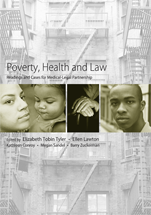 Poverty, Health and Law: Readings and Cases for Medical-Legal Partnership Poverty, Health and Law: Readings and Cases for Medical-Legal Partnership 
Book by edited by Elizabeth Tobin Tyler et al. Not every illness has a biological remedy. Poverty, Health and Law presents health in the broader social context of people’s lives, providing insights into the advancement of health through legal advocacy and interdisciplinary solutions to complex social problems.
Focusing on basic legal rights and their relation to health—income and employment, housing, education, legal status, and personal safety—the authors provide information and insight into how the law may be used as a tool to improve health and how health care providers and lawyers can work together to invoke more effective and preventive remedies for patients and clients. |
 |
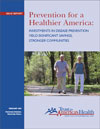 Prevention for a Healthier America: Investments in Disease Prevention Yield Significant Savings, Stronger Communities (pdf) Prevention for a Healthier America: Investments in Disease Prevention Yield Significant Savings, Stronger Communities (pdf) 
REPORT developed in a partnership of the Trust for America’s Health, The Urban Institute, The New York Academy of Medicine, the Robert Wood Johnson Foundation, The California Endowment, and Prevention Institute. Feb 2009
This study examines how much the country could save in health care costs if we invested more in disease prevention, specifically by funding proven community-based programs that result in increased levels of physical activity, improved nutrition (both quality and quantity of food), and a reduction in smoking and other tobacco use rates. |
 |
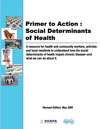 Primer to Action: Social Determinants of Health Primer to Action: Social Determinants of Health 
REPORT by the Ontario Prevention Clearinghouse, 2007 This resource is for health professionals, lay workers, volunteers and activists. It’s for you and your organization, but also for your family, and your community. We will focus on six key determinants of health: income, education, employment, housing, food, and inclusion. The Primer to Action will show you:
1) where you can find more information about each of six determinants;
2) how you can work on the determinants in your agency;
3) who you can learn from, with examples and models; and
4) what you can do in your community. |
 |
 Promoting Health Equity: A Resource to Help Communities Address Social Determinants of Health (pdf) Promoting Health Equity: A Resource to Help Communities Address Social Determinants of Health (pdf) 
WORKBOOK - Centers for Disease Control and Prevention, 2008 This workbook is for community-based organizations seeking to affect the social determinants of health through community-based participatory approaches and nontraditional partnerships. Along with an introduction to the concepts of health equity, the workbook presents case studies of communities working at both small and large scales. The authors then provide guidelines for developing your own initiative, from creating partnerships to identifying your approach to assessing and maintaining your progress. |
 |
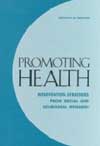 Promoting Health: Intervention Strategies from Social and Behavioral Research Promoting Health: Intervention Strategies from Social and Behavioral Research 
BOOK edited by Brian Smedley and S. Leonard Syme, 2000 This book identifies promising areas of social science and behavioral research that may address public health needs. The editor's description reads: "Approximately half of all causes of mortality in the United States are linked to social and behavioral factors such as smoking, diet, alcohol use, sedentary life-style, and accidents. Yet less than 5% of the approximately $1 trillion spent annually on health care in the United States is devoted to reducing risks posed by these preventable conditions. Behavioral and social interventions therefore offer great promise to reduce disease morbidity and mortality, but as yet their potential to improve the public's health has been relatively poorly tapped."
See especially, "Understanding and Reducing Socioeconomic and Racial/Ethnic Disparities in Health," by James S. House and David R. Williams. |
 |
Public Health Advocacy Curriculum 
Public Health Advocacy Curriculum: This ten-lesson curriculum combines classroom- and community-based activities to teach students about the upstream or root causes of health, and to encourage them to become health advocates. |
 |
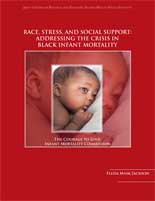 Race, Stress, and Social Support: Addressing the Crisis in Black Infant Mortality Race, Stress, and Social Support: Addressing the Crisis in Black Infant Mortality 
REPORT by Fleda Mask Jackson, from the Health Policy Institute, 2007 This background paper examines the impact of stress and stress mediators on pregnancy outcomes for African American women. The report also examines social support and other relational experiences, and makes recommedations for related changes in public policy and maternal and child health practices. |
 |
 Reaching for a Healthier Life: Facts on Socioeconomic Status and Health in the U.S. (pdf) Reaching for a Healthier Life: Facts on Socioeconomic Status and Health in the U.S. (pdf) 
REPORT from The John D. and Catherine T. MacArthur Foundation Research Network on Socioeconomic Status and Health, 2007 An overview of how socioeconomic status affects health, though consideration of neighborhood, employment conditions, personal behaviors, health care, race and stress. Includes policy implications. The MacArthur Network on SES and Health brings together many of the world's top researchers on socioeconomic factors in health. Many of these experts were interviewed for UNNATURAL CAUSES. |
 |
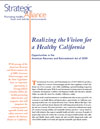 Realizing the Vision for a Healthy California (pdf) Realizing the Vision for a Healthy California (pdf) 
POLICY BRIEF from Strategic Alliance, 2009
The Strategic Alliance for Healthy Food and Activity Environments has developed recommendations for taking advantage of opportunities from the American Recovery and Reinvestment Act of 2009 to improve the health and safety of all Californians.
|
 |
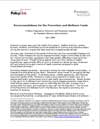 Recommendations for the Prevention and Wellness Funds (pdf) Recommendations for the Prevention and Wellness Funds (pdf) 
POLICY MEMO from PolicyLink and Prevention Institute, April 2009 This memo offers recommendations for targeting Prevention and Wellness recovery funds to maximize the health and equity benefits in the Recovery Act of spring 2009. It makes the case that prioritizing disease prevention – particularly among the most impacted communities – is imperative to strengthening the nation. It makes specific recommendations for using funds to
- Build upon and leverage existing prevention initiatives;
- Promote equity by targeting America’s low-income communities and communities of color;
- Target multi-disciplinary strategies focused on environmental change;
- Develop the health workforce to effectively shape and implement prevention efforts; and
- Advance a vision of healthy people, healthy places. |
 |
 Reducing Health Disparities For Latino Immigrants By Strengthening Communities (pdf) Reducing Health Disparities For Latino Immigrants By Strengthening Communities (pdf) 
REPORT from PolicyLink and the Joint Center for Political and Economic Studies, Washington, DC, May 2004 This brief examines the ways in which the social, economic, and physical environments of Latino immigrant communities affect health and contribute to health disparities. The first part discusses the health of Latino immigrants in general and how health status is influenced by community factors related to immigrant status. The next part describes key immigration trends and explores some of the defining characteristics of this population, including issues unique to immigrant communities, such as language, legal status, settlement patterns, and community development issues. The third part discusses the importance of community approaches to immigrant health and describes several successful community efforts that build on the assets of Latino immigrant communities in order to improve health. Finally, we offer a number of policy recommendations designed to improve health and reduce disparities for Latino immigrants by strengthening the communities in which they live. |
 |
 Reducing Health Disparities Initiative Reducing Health Disparities Initiative 
WEBSITE by Contra Costa Health Services CCHS has a department-wide goal to reduce health disparities by addressing issues of diversity and linguistic and cultural competence. Their site contains community health indicators for Contra Costa County, information on the county's five-year plan, and promising practices for cultural competence. |
 |
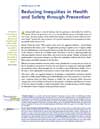 Reducing Inequities in Health and Safety through Prevention (pdf) Reducing Inequities in Health and Safety through Prevention (pdf) 
POLICY MEMO from Prevention Institute and the Health Policy Institute of the Joint Center for Political and Economic Studies, January 23, 2009
Advancing health equity to ensure all Americans have the opportunity to lead healthy lives should be a priority. We have an opportunity to do so in a way that alleviates pressure on the health system and saves money. This memo was developed in January '09 to provide background and recommendations for developing a comprehensive, prevention-oriented strategy for acheiving health equity.
|
 |
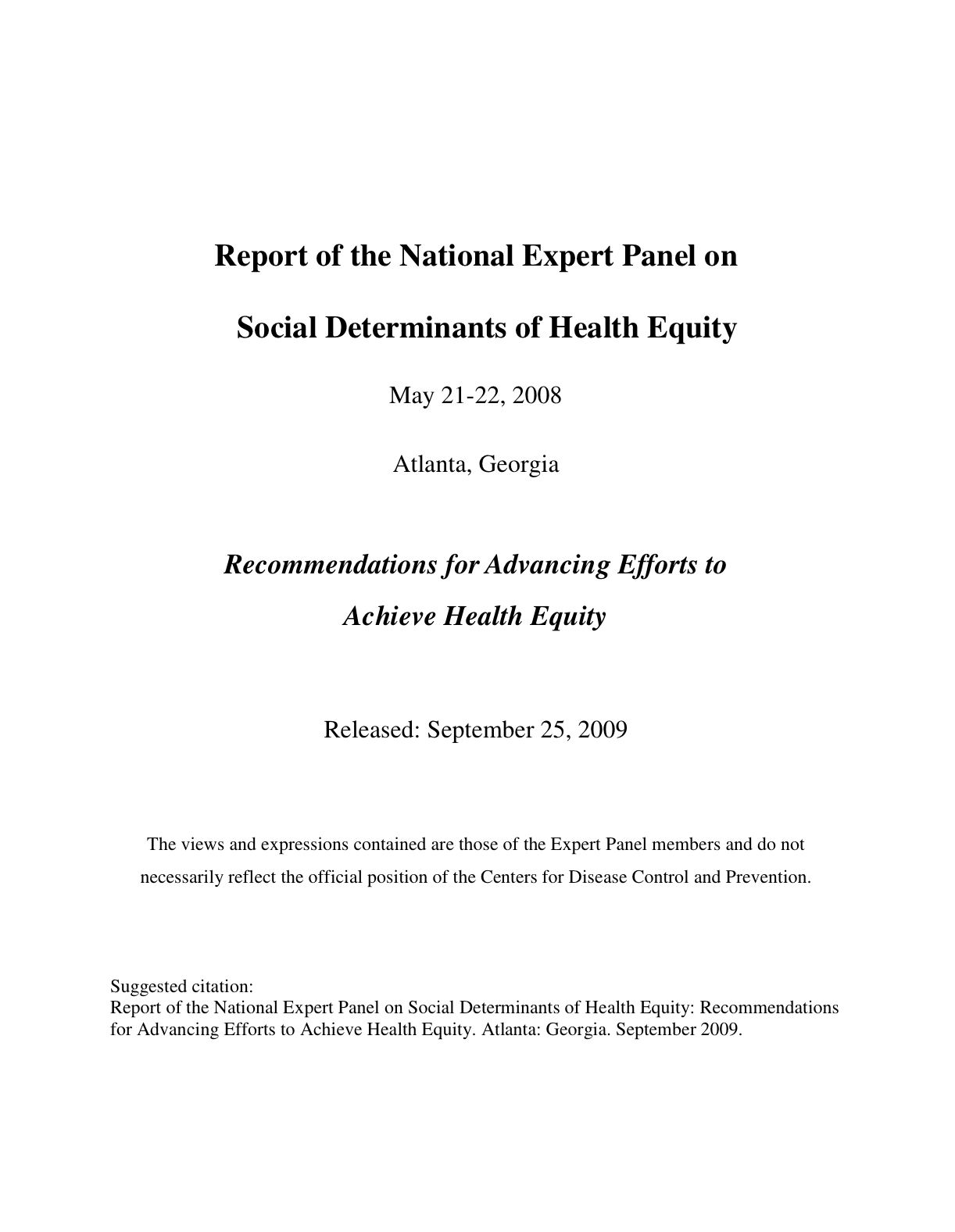 Report of the National Expert Panel on Social Determinants of Health Equity: Recommendations for Advancing Efforts to Achieve Health Equity Report of the National Expert Panel on Social Determinants of Health Equity: Recommendations for Advancing Efforts to Achieve Health Equity 
This report encapsulates the critical thinking, key arguments and recommendations of nationally recognized experts in the area of social determinants of health equity. A principle thesis of the Expert Panel is that the inequitable distribution of resources needed for health is the major contributor to persistent health inequities. These experts called to account conditions and processes, including class disadvantage and racism, that prevent many Americans from enjoying the health and long life that affluent and privileged citizens take for granted. Many of the strategies for addressing social determinants of health equity fall outside current public health practice but not outside the profession’s historic role in public policy decisions that promote social justice. |
 |
 Research: Green areas lower health inequities between rich, poor Research: Green areas lower health inequities between rich, poor 
NEWS ARTICLE, USA Today, Nov 11, 2008 Health inequalities between rich and poor people are much lower in areas that have lots of green space, such as parks, forests and playing fields, a large British study finds. |
 |
 Rethinking Schools Rethinking Schools 
WEB SITE Rethinking Schools began in 1986 as a local effort to address problems such as basal readers, standardized testing, and textbook-dominated curriculum. Since its founding in 1986, it has grown into a nationally prominent publisher of educational materials. While the scope and influence of Rethinking Schools has changed, it remains firmly committed to equity and to the vision that public education is central to the creation of a humane, caring, multiracial democracy. While writing for a broad audience, Rethinking Schools emphasizes problems facing urban schools, particularly issues of race |
 |
 Ron Sims: The King County Equity and Social Justice Initiative Ron Sims: The King County Equity and Social Justice Initiative 
TRANSCRIPT of a speech by Rom Sims, King County Executive, March 2008 In a speech for the CDC Health Transformation Lecture Series, Mr. Sims explains how his office has made health equity central to its work - across sectors and in partnership with communities, business, and local agencies - and makes the case for the CDC to use its considerable influence and reach to promote and support health equity nationally. |
 |
 San Francisco Paid Sick Leave Ordinance (pdf) San Francisco Paid Sick Leave Ordinance (pdf) 
PRESENTATION SLIDES, SF Office of Labor Standards Enforcement, January 11, 2007 Passed by a 61% majority vote, Proposition F required that all employers must provide paid sick leave to each employee who performs work in San Francisco, starting in 2007. This pdf of a slideshow explains some of the background and details of the ordinance, and provides statistics and details regarding its importance. |
 |
 Seattle Healthy Homes Project - Healthy Homes II Asthma Project Seattle Healthy Homes Project - Healthy Homes II Asthma Project 
WEBSITE by the King County Asthma Forum Includes tools for community health worker programs, resources, and references to academic studies on the project. |
 |
 Smart Growth Online Smart Growth Online 
WEB SITE In 1996, the U.S. Environmental Protection Agency joined with several non-profit and government organizations to form the Smart Growth Network (SGN). The Network was formed in response to increasing community concerns about the need for new ways to grow that boost the economy, protect the environment, and enhance community vitality. The Network's partners include environmental groups, historic preservation organizations, professional organizations, developers, real estate interests; local and state government entities. |
 |
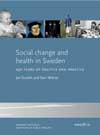 Social change and health in Sweden - 250 years of politics and practice Social change and health in Sweden - 250 years of politics and practice 
BOOK by Jan Sundin and Sam Willner, Swedish National Institute of Public Health, 2008 This thorough text examines the history of public health in Sweden, with particular attention to the emergence of the welfare state in the past century. Say the authors, "Historical lessons cannot be transferred uncritically from one country to another. However, differences and similarities in appropriate contexts can increase our understanding of relations between health and society. We hope that this book will be useful for policy comparisons and in the training of public health policy-makers, researchers, administrators and practitioners."
Full pdf available online, 5 MB. |
 |
 Social conditions, health equity, and human rights Social conditions, health equity, and human rights 
Paula Braveman This paper explores connections between human rights and health equity, focusing particularly on the implications for both fields of the link between social conditions and both health and health inequalities. Human rights laws and principles and health equity concepts and technical approaches can be powerful tools for mutual strengthening, not only by contributing toward building awareness and consensus around shared values, but also by guiding analysis and strengthening measurement of both human rights and health equity. |
 |
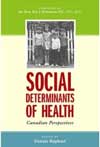 Social Determinants of Health: Canadian Perspectives Social Determinants of Health: Canadian Perspectives 
BOOK edited by Dennis Raphael Uniting top academics and high profile experts from across the country, this contributed volume summarizes how socio-economic factors affect the health of Canadians, surveys the current state of eleven social determinants of health across Canada, and provides an analysis of how these determinants affect Canadians' health. In each case, the book explores what policy options would contribute to better health outcomes. and how to ensure that these options are pursued. Eleven critical areas are investigated: Aboriginal status, early life, education, employment and working conditions, food security, health care services, housing, income and its distribution, social safety net, social exclusion, as well as unemployment and employment security. Gender, and how its meaning is constructed within Canadian society, is another important social determinant of health. All contributors systematically consider how it impacts upon and interacts with their specific social determinant of health to influence health.
|
 |
| « Prev 1 | 2 | 3 | 4 | 5 | 6 Next » |
|




